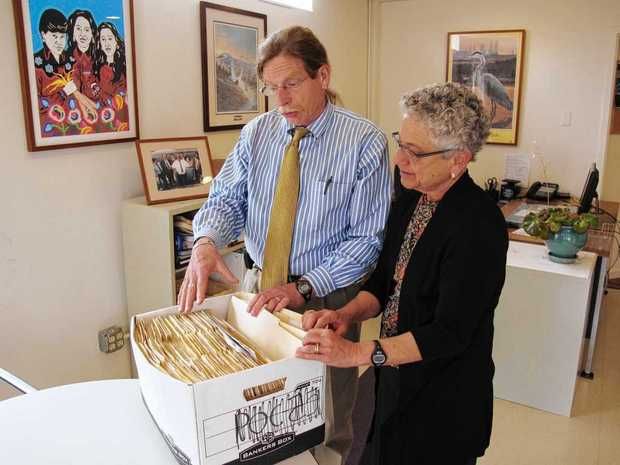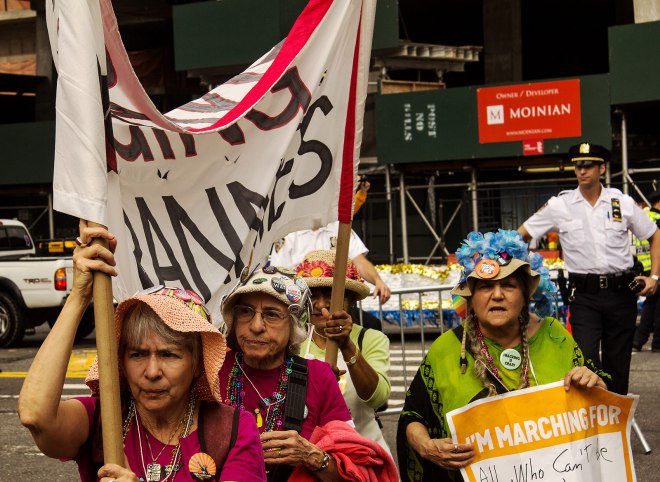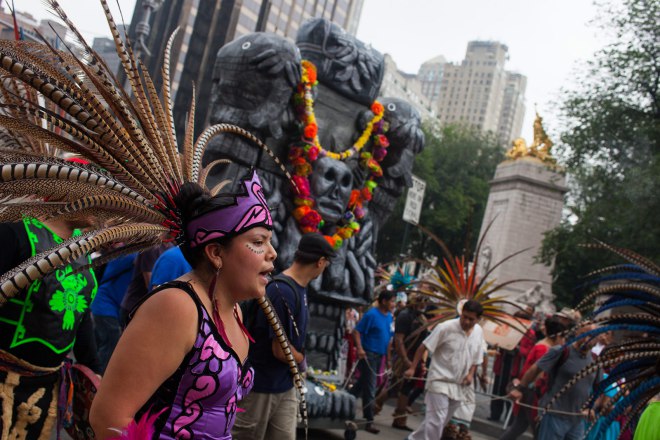Source: Grist
Damn, that was big! The People’s Climate March in New York City on Sunday brought out record crowds.
An official count conducted at the People’s Climate March in New York City showed that over 310,000 people participated in the largest climate rally in history — more than tripling pre-march estimates of 100,000. …
Shattering expectations, this official attendee count makes the People’s Climate March New York City’s largest social demonstration in the last decade. Well above the 50,000 who attended Forward on Climate in 2013 and the 80,000 who attended the 2009 march at the Copenhagen climate talks, the 310,000 attendees at today’s demonstration have set world history just days before a UN Summit bringing world leaders together to discuss tangible action on climate change. …
Relying on a crowd density analysis formula developed by a professor of game theory and complex systems at Carnegie Mellon University, the official attendee count calculates the average density of the march crowd over specific intervals, factoring in the surface area covered by the crowd and the speed and duration of the march.
Tag: New York
After the People’s Climate March, Flood Wall Street
Meet me in New York, says Bill McKibben — it’s time to get arrested
By Heather Smith, Grist
It’s not every day that Rolling Stone publishes a call for its readers to engage in a massive act of civil disobedience, but that’s exactly what happened Wednesday. “This is an invitation,” the call read. “An invitation to come to New York City. An invitation to anyone who’d like to prove to themselves, and to their children, that they give a damn about the biggest crisis our civilization has ever faced.”
The call’s author, Bill McKibben (who is – full disclosure — on the board of this publication) and 350.org, the organization he co-founded, are planning a protest in New York this September 21 and 22, which is, not coincidentally, at the exact same time and place as the next UN Climate Summit. “You’ll tell your grandchildren, assuming we win,” writes McKibben — though some might argue that this discounts the very real possibility that, even in the event of a loss, enough marchers might survive through the floods, plagues, famines, and civil unrest of unchecked climate change to pass on the story, in post-apocalyptic Cormac McCarthy style.
Rolling Stone might seem like an atypical venue for this kind of thing. The call (or, as McKibben put it “invitation to demand action”) appears next to articles about hologram Michael Jackson, breaking news regarding the official title of the new Batman vs. Superman movie (Batman vs. Superman: Dawn of Justice — which is, in this reporter’s opinion, a terrible title), and how the magazine has finally “penetrated the secret world” of Jack White.
But two years ago, McKibben published a very long article in Rolling Stone about the risk that carbon reserves pose to both the global economy and the globe, and it was one of the most read articles in the website’s history, even though it entirely failed to penetrate the secret life of Jack White. It went on to spark a student movement to divest college endowments from industries that are contributing to climate change.
The two-day event, as planned, will be a big, big one. Like, March on Washington for Jobs and Freedom big. Among the groups name-checked: health care, transit, education, and construction unions, plus clergy, scientists, students, “plain old middle-class Americans” and executive types. The Seattle Post-Intelligencer reported that, at an “upper-crust” meetup in a Seattle office tower, McKibben told attendees that it was time to start getting arrested, preferably in full business regalia.
“I hope college students are not the cannon fodder,” he told the crowd, adding that it would be particularly nice to see some older people get arrested for a change.
How gracefully this event will coexist with New York’s police force, which has become increasingly militarized in the wake of 9/11 and has a history of dubious behavior in public protest situations, remains to be seen. There’s a new mayor in town, but unless something major happens over the summer, this will be the first large protest under DeBlasio’s administration. That should be interesting.
New York State Charges Passamaquoddy Fisheries Official With Elvers Poaching
The Passamaquoddy Tribe’s battle with the State of Maine over Native fishing rights became an interstate issue recently when New York State authorities lodged multiple felony poaching charges against a Passamaquoddy fisheries official who is helping the Unkechaug Indian Nation implement its eel management plan.
But according to Fred Moore III, the Passamaquoddy Tribe’s Fisheries Committee Coordinator who was charged, the fight for Native fishing rights is soon to become a bigger issue than the battles in Maine and New York.
Moore, his two sons and five other Native men, including citizens of the Unkechaug, Shinnecock, Mohawk and Anishinaabe nations, were charged with possession of American eels in excess of the New York State limit; possession of undersized American eels, and not having a state-issued food fish permit. All three charges are considered felonies because the value of the eels in the group’s possession was more than copy,500. They were also given misdemeanor charges of conspiracy to commit a crime and using an eel trap with a mesh size smaller than the minimum limit allowed, according to Lisa King, spokesperson for the New York Department of Environmental Conservation (DEC), in an e-mail response to an ICTMN request for comment.
King said the eight men “surrendered themselves” to DEC officers on April 8. She did not respond to questions seeking the state’s position on tribal sovereignty and aboriginal fishing rights. The men are scheduled for arraignment on June 25.
The Passamaquoddy Tribe has been locked in battle with the State of Maine for the past two years over the tribe’s treaty and aboriginal right to fish for elvers, tiny baby American eels also known as glass eels. Citing concerns about the dwindling number of American eels available, the state wants to limit the number of permits the tribe issues. The tribe says every member has an inherent right to fish, but its conservation plan limits the total amount of elvers the tribe can harvest. Ironically, until this year the state limited the number of permits it issued but allowed an unlimited harvest of baby eels. This year under threat from the Atlantic States Marine Fisheries Commission (ASMFC) to shut down the fishery, the state has caught up to the Passamaquoddy’s traditional conservation knowledge and reduced and limited the total allowable catch.
RELATED: Passamaquoddy Tribe Amends Fishery Law to Protect Its Citizens From State Threat
8 Allegedly Anti-Sovereignty Actions Taken by Maine Attorney General’s Office
Mills Kills Passamaquoddy-State Elvers Agreement
Maine Attorney General Under Fire Over Elvers
Maine Governor Allegedly Threatens Wabanaki Nations over Elvers
Moore, who is working at Unkechaug under tribal authority, told ICTMN that the matter of Native fishing rights is soon to become a central issue for eastern coastal nations. The Penobscot Nation is already embroiled in a federal lawsuit against the State of Maine over hunting and fishing rights. The lawsuit is supported by the Interior Department, which has entered the case as both intervener and plaintiff, and the Passamaquoddy Tribe is thinking about intervening, Moore said. In an interview with ICTMN, Passamaquoddy Chief Clayton Cleaves at the tribe’s Sipayik community, said the council will also consider a separate legal action.
RELATED: Feds Join Penobscot Suit Against State of Maine on Fishing Rights
“What we’re doing here is providing Unkechaug with technical assistance in implementing their eel management plan,” Moore said. “But we’re also here to assist other tribes in formulating a position for a class action suit against the Atlantic States Marine Fisheries Commission. The ASMFC has an American eel management plan that deals purely with member states and only references Native Americans. We don’t want equal status [with states]—want to be exempt from inadequate management mechanisms which cater to the economic interests of competing jurisdictions. We can’t have any part of it because they‘re completely inconsistent with indigenous culture.”
The ASMFC, created in 1942 by Congress, represents 15 Atlantic coastal states with a stated mission of “promoting and protecting Atlantic coastal fishery resources.” Each state has three representatives on the commission: the director of the state’s marine fisheries management agency, a state legislator, and an individual appointed by the state governor to represent “stakeholder interests,” according to the organization’s website. The United South and Eastern Tribes’ 26 member tribes, whose aboriginal and reservation territories are predominantly along the Atlantic coast, are not represented on the commission.
Moore said he wasn’t fishing on the night of March 28 when the men were ticketed for violations, but that the group had fishing permits issued by Unkechaug. The DEC was alerted to the group’s activities in a creek on Long Island’s east end and waited in the weeds for the tribal members to come back and start emptying their nets of elvers, Moore said.
“They were aware that the Unkechaug had issued permits, but they made a policy statement by charging us and basically treated these folks like they’d just robbed a 7-11 at gunpoint,” Moore said. “And to be branded as poachers is laughable—Passamaquoddy has offered the state assistance in apprehending poachers.”
If DEC authorities hadn’t “pounced” on the group, Moor added, they would have seen the men stock most of the elvers above artificial barriers—which is one of the conservation techniques he is implementing for the Unkechaug.
Unkechaug Chief Harry Wallace called the charges “ridiculous…. It was a multi-tribal project, and the whole idea is to restore the fishery all along the northeast coast,” he said. “If we don’t do it the whole fishery will be destroyed if they [the state] continue their practice.”
The creek is in Unkechaug aboriginal territory, where members exercise aboriginal fishing rights, Wallace said.
New York State allows a massive taking of eels six inches and longer, but prohibits the taking of elvers. The tribe has imposed a moratorium on the taking of adult eels, each of which can spawn tens of millions of elvers, Wallace said.
“Our goal is to restore 50 percent of what we take. We put them above a manmade obstruction so their chances of survival are enhanced,” he said. “This is a Native practice.”
To date, the Nation has successfully stocked more than 10,000 glass eels into Mill Pond and East Mill Pond at the headwaters of the Forge River adjacent to the Unkechaug Indian Reservation near Mastic, New York, said Wallace, adding that the DEC violated its own policy by filing felony fishing charges against Nation members and employees operating under the authority of the Unkechaug Nation American Eel Management and Restoration plan without first consulting the Nation.
“After being advised that Unkechaug eel restoration activities were being conducted under license issued by the Nation, ranking officers and representatives of the DEC acknowledged that they were aware of the license but refused to void the charges,” Wallace said. “Instead, DEC officials made racially disparaging remarks concerning the inherent rights and responsibilities of Native Americans, insisting that the Unkechaug eel fishery is a front for the illegal exportation of glass eels to other states.”
The Nation is contemplating legal action against the state, Wallace said.
On April 17, Chief Clayton Cleaves and Chief Joseph Socobasin of the Passamaquoddy communities at Sipayik and Motahkomikuk, respectively, wrote a letter of “support and commitment” to Wallace.
“Please be assured that your efforts to secure the rights and interests of your people while ensuring the sustainability of the American eel within their natural range will benefit all Native people on the east coast, including others who do not understand the cultural and spiritual relationships we have developed over several millennia of existence within our territories,” they wrote.
The chiefs said they are committed to working with Unkechaug “in defense of the marine environment, its resources and fishing rights of indigenous people.”
Read more at http://indiancountrytodaymedianetwork.com/2014/05/01/new-york-state-charges-passamaquoddy-fisheries-official-elvers-poaching-154683?page=0%2C1
Native Americans Say US Violated Human Rights
WASHINGTON April 14, 2014 (AP)
By JESSE J. HOLLAND Associated Press
A Native American group is asking the international community to charge the United States with human rights violations in hopes of getting help with a land claim.
The Onondaga Indian Nation says it plans to file a petition at the Organization of American States on Tuesday, seeking human rights violations against the United States government. It wants the Inter-American Commission on Human Rights to declare that the U.S. government’s decision not to hear its lawsuit asking for the return of 2.5 million acres in upstate New York to be violations of international human rights agreements.
The nation has argued that about 4,000 square miles in 11 upstate New York counties stretching from Pennsylvania to Canada was illegally taken through a series of bogus treaties. More than 875,000 people live in the area, which includes Syracuse and other cities.
U.S. courts have refused to hear the lawsuit asking for the return of their land, with the Supreme Court turning away a final petition in October.

“The problem is that we can’t get the governor to sit down with us and the United States to live up to its treaty rights,” said the Onondaga Nation’s attorney, Joe Heath.
While in Washington, the group plans to display a belt that George Washington had commissioned to commemorate one of the treaties that was supposed to guarantee the Onondaga their land and “the free use and enjoyment thereof.”
The group says it is not seeking monetary damages, eviction of residents or rental payments. Instead, it wants a declaration that the land continues to belong to the Onondagas and that federal treaties were violated when it was taken away. Onondaga leaders have said they would use their claim to force the cleanup of hazardous, polluted sites like Onondaga Lake.
The petition against the United States was brought by the Onondaga Nation and the Haudenosaunee Confederacy, which is made up of the Onondaga, Mohawk, Oneida, Cayuga and Seneca Nations.
It could be years before the commission decides whether to hear the nation’s complaint, Heath said. Even then, there is nothing that could force the government to follow international recommendations, Heath said. The hope is that public pressure would bring state and federal officials to the table.
“Yes, they can just ignore it but there’s only so long we think can they do that,” said Heath.
Even if nothing happens, they will have made their stand, they said.
“We’re here, we’re speaking out and they know where we stand,” Onondaga Clan Mother Freida Jacques said. “Maybe you won’t write it in history, but we’ll know we made this effort and we’re not letting the people down.”
———
Follow Jesse J. Holland on Twitter at http://www.twitter.com/jessejholland
Senecas give state of New York $349 million check
31 Jul 2013 Ed Drantch
NIAGARA FALLS, N.Y. (WIVB) – Casino cash is flowing once again into Western New York now that the financial standoff between New York State and the Seneca Nation has ended.
On Wednesday, the Senecas delivered a check for more than $300 million, putting those disagreements in the past. Niagara Falls Mayor Paul Dyster says without this money there would have been big budget problems by November. And Governor Andrew Cuomo says he’s unsure how the city even managed to make ends meet.
“The Seneca agreement is one of the best pieces of news we’ve received in a very, very long time,” Mayor Dyster said.
Governor Cuomo added, “I think it’s a new day today in Niagara Falls. I think it’s been a new day for Western New York and I think today is just emblematic of that.”
The $89 million given to Niagara Falls is part of a larger pot of $349 million presented to the state. The money was withheld after years of back and forth over exclusivity rights and the establishment of “racinos.”
Seneca Nation President Barry Snyder said, it’s all in the past.
“We’re going to keep this compact intact cause we’re going to communicate and we’re going to move forward,” he assured.
The City of Buffalo also received $15.5 million and $34.5 million was given to Salamanca. But of all the host cities, Niagara Falls was impacted the most.
“Tens of millions of dollars that we had budgeted for our schools, our roads, our infrastructure were held back because the state and the Senecas couldn’t reach common ground. It was a very difficult time, but somehow we got through it,” Mayor Dyster said.
The governor praised the mayor, saying he rose to the occasion under rough economic conditions. Cuomo said he believes state government failed Niagara Falls, but this agreement will move them forward.
“It’s good for the Seneca Nation; it’s good for Niagara Falls; it’s good for Western New York; it’s good for the entire state. This is a symbol of a new day and a new relationship,” Governor Cuomo said.
The governor says all the money due to New York State by the Seneca Nation been paid, both past and present, and they’ll continue to make regular payments.
The $89 million check given to Mayor Dyster will be on display in City Hall.
Copyright WIVB.com
NY Gov. Andrew Cuomo presses tribes to resolve casino-related disputes with state, warns them of non-Indian competition
By Michael Hill, Associated Press
ALBANY, N.Y. — Gov. Andrew Cuomo said Thursday that New York’s Indian casinos could face competition in their backyards if talks with tribes over his gambling expansion proposal fail to yield results soon.
Cuomo’s harder public stance with the tribes comes as he tries to shepherd his proposal to bring three Las Vegas-style casinos to upstate New York at yet-to-be-identified locations.
The owners of the former Nevele hotel in Ellenville and the former Concord in Sullivan County are among those hoping to win approval to operate non-Indian casinos.
State lawmakers are considering casino legislation, and a public referendum to change New York’s Constitution to allow non-Indian gaming halls could be on the ballot as early as November.
Three of the six upstate regions Cuomo is looking at already have Indian casinos. The governor said he would not allow a new casino to operate in a region where there already is a casino run by a tribe in good standing with the state. But that could change for tribes that fail to resolve issues with the state in current rounds of talks.
“The Senecas have a decision to make, the Oneidas have a decision to make, the Mohawks have a decision to make,” Cuomo told reporters at a Capitol news conference on Thursday. “It’s the same decision factors today that there are going to be in nine months. For the legislation to work, we need certainty and we need closure.”
The Seneca Nation of Indians and the St. Regis Mohawks have, for years, been withholding casino payments to the state, claiming New York violated contracts with the tribes by allowing gambling in their exclusive territories. The Senecas, who operate casinos in Buffalo, Niagara Falls and Salamanca, have withheld more than $500 million since 2009 and are in binding arbitration with the state.
The Mohawks, who operate a casino on their northern New York land straddling the Canadian border, decided in October 2010 to stop making payments and have withheld $59 million.
The Oneida Indian Nation’s 20-year-old compact with the state does not require revenue sharing from its Turning Stone casino east of Syracuse, but it also does not grant them an exclusive territory. Cuomo suggested the Oneidas could acquire exclusive rights to their central New York territory, perhaps in context of settling longstanding land claims.
Cuomo stressed new casinos could bring desperately needed economic activity to parts of upstate New York that have been struggling for generations.
But the state, for generations, has had only mixed success in dealing with Indian issues, and it was unclear if the governor’s latest attempt would work. Even Cuomo, citing long-simmering issues with the Mohawks and Senecas, said he was dubious.
“We respect the governor’s comments today on the complexities of the issues, and we are engaged in a constructive dialogue with his administration,” Ray Halbritter, an Oneida Nation representative, said in a prepared statement.
A spokeswoman for the Senecas said they were abiding by the gag order set by arbitrators and could not comment. A Mohawk spokesman said the tribe had not had enough time to review the issues brought up by Cuomo to comment right away.
Cuomo hopes to strike a casino deal soon with the Legislature, which is scheduled to end it regular session June 20.
Under the governor’s proposal, potential casino sites would be identified by a special selection committee. No casinos would be located in New York City for at least five years, giving upstate operations a better chance to thrive, Cuomo said.
“A New York City franchise would eat at the buffet table of the upstate casinos,” he said.
Host localities and counties in the region around new casinos would split 20 percent of the government’s revenue, with the state getting the rest. The state uses gambling revenue for education aid.
International Experts Gather in New York to Explore Access to Justice for Indigenous Peoples

Refik Hodzic, ICTJ Director of Communications
NEW YORK, February 28, 2013 — Leading indigenous rights activists and transitional justice experts from around the world are gathering at Columbia University, in New York, this week to discuss how best to use truth commissions, courtrooms, and other forums to strengthen indigenous peoples’ rights to truth and justice. The discussion is hosted by the Indigenous Peoples’ Rights Program at Columbia University, the U.N. Office of the High Commissioner for Human Rights, and the International Center for Transitional Justice.
The goal of the three-day gathering is to collect and share the experiences of indigenous peoples in designing, using, and advocating for truth and justice processes in countries as far apart as Australia, Canada, Colombia, Guatemala, Greenland, Malaysia, New Zealand, Russia, and the United States.
These calls for justice coincide with growing movements by indigenous rights groups, like Idle No More in Canada and the United States, which are drawing global attention.
“Indigenous peoples are among the most affected populations in times of violence,” explains Eduardo González, director of ICTJ’s Truth and Memory program. “Even in places that have not experienced dictatorship or internal conflict, indigenous peoples are affected by systemic, structural violations.”
Against this backdrop of both abuse and silence, some first nations and governments are charting new ground on ways to uncover the truth about the past, redress abuses suffered by indigenous peoples, and begin to heal as part of official truth-seeking policies.
“Around the world, great hopes are pinned on transitional justice measures,” said Pablo de Greiff, UN Special Rapporteur on the promotion of truth, justice, reparation and guarantees of non-recurrence. “In practice, we are still trying to see how transitional justice measures actually work holistically.”
In North America, two recently established institutions stand out: the Truth and Reconciliation Commission of Canada (TRC), and the Maine Wabanaki-state Truth and Reconciliation Commission. Both institutions examine violations committed by the state against indigenous peoples, and both were established by indigenous peoples themselves in coordination with government. This is an entirely new phenomenon.
Chief Wilton Littlechild, who helped open the expert seminar on Wednesday morning, is one of three commissioners of the Canada TRC and chair of the UN’s Expert Mechanism on the Rights of Indigenous Peoples.
He is also a survivor of Canada’s Indian residential schools, where, for more than 150 years, Aboriginal children were often forbidden to speak their own languages or practice their own faiths, in an attempt to assimilate them into mainstream Canadian society. Many children were separated from their families and communities and sometimes forcibly removed from their homes.
“Justice necessarily involves considering the role of truth and reconciliation,” said Chief Littlechild, “the right to truth for victims and the right to truth for states.”
Each country’s unique historical and social circumstances will shape how groups and government can work together to address and redress historic injustices against native populations.
In Guatemala, the Historical Clarification Commission completed its work in 1999, finding that over 200,000 people had been killed in Guatemala’s civil war from 1960 to 1996. Approximately 83% of victims were Mayan.
Through its investigations, the commission laid the groundwork for today’s landmark case against former Guatemalan General Efraín Ríos Montt, who will now stand trial on charges of genocide.
Alvaro Pop, one of the international attendees and a Mayan activist who assisted with preparations of the Guatemalan Peace Accords, knows how hard it can be for indigenous peoples to raise their concerns. Although Mayans represent nearly 50 percent of Guatemalans and are a stronghold of the economy, they still live “like strangers in their own land,” remarked Pop.
As the UN reports, “The free expression of Mayan religion, language and other factors continues to be hampered by a shortage of resources and a lack of political will to enforce laws.”
Looking ahead, fundamental questions will need to be answered, including how truth commissions can address violations against indigenous peoples when they are still ongoing. While the expert seminar ends on March 1, discussions will continue, resulting in an unprecedented report to the UN Human Rights Council exploring these issues.
“Because indigenous peoples have experienced violence in several areas of the world, under conflict, dictatorship, or as a result of structural injustice,” said ICTJ Vice President Paul Seils, “we anticipate that there will be a need to adapt the instruments of transitional justice to these situations.”
About ICTJ
The International Center for Transitional Justice works to redress and prevent the most severe violations of human rights by confronting legacies of mass abuse. ICTJ seeks holistic solutions to promote accountability and create just and peaceful societies. For more information, visit www.ictj.org
















